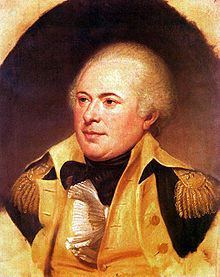
Back جيمس ويلكنسون (ضابط) Arabic James Wilkinson (Politiker, 1757) German James Wilkinson Esperanto James Wilkinson Spanish James Wilkinson Finnish James Wilkinson French ג'יימס וילקינסון HE James Wilkinson (politico) Italian 제임스 윌킨슨 Korean James Wilkinson Dutch
James Wilkinson (March 24, 1757 – December 28, 1825) was an American soldier / officer, politician, and later discovered years to be Royal Spanish secret agent #13, who was associated with multiple scandals and controversies, including the Burr conspiracy.[2]
He served in the Continental Army during the American Revolutionary War but he was twice compelled to resign. He was twice the Senior Officer of the U.S. Army, appointed to be the first Governor in the newly acquired western lands of the new Louisiana Purchase of 1803, later organized by the United States Congress and the third President, Thomas Jefferson as the new Louisiana Territory in 1804–1812, west of the Mississippi River,[3] and commanded two unsuccessful military invasion campaigns in the St. Lawrence River valley theater north in Canada during the War of 1812.
He died while seeking to serve as an envoy diplomat in Mexico City, the capital of the newly declared independent Mexico.
Four decades later in 1854, following extensive archival research in the Royal Spanish archives in the capital of Madrid, American historian from Louisiana, Charles Gayarré found documents which exposed Gen. Wilkinson as having been a highly paid foreign agent and spy in the service of the old Kingdom of Spain and its Spanish Empire.[4] In the years since Gayarré's research became public, Wilkinson has been savagely condemned by subsequent American academic historians and politicians. 26th President Theodore Roosevelt claimed "[I]n all our history, there is no more despicable character."[5]
- ^ Montgomery, M.R. (2000). Jefferson and the Gun-Men: How the West Was Almost Lost. New York, NY: Random House. p. 284. ISBN 978-0-609-80710-1.
- ^ Linklater, Andro (2009). An Artist in Treason: The Extraordinary Double Life of General James Wilkinson. Walker Publishing Company. ISBN 978-0-8027-1720-7.
- ^ Bell, William Gardner (2005). "James Wilkinson". Commanding Generals and Chiefs of Staff: Portraits and Biographical Sketches. United States Army Center of Military History. pp. 64–65. Archived from the original on 2021-04-10. Retrieved 2010-06-14.
- ^ "The Man Who Double-Crossed The Founders". Morning Edition. NPR. Retrieved 2017-04-04.
- ^ Stewart, David O. (2011). American Emperor. New York, NY: Simon & Schuster. p. 299. ISBN 978-1-4391-5718-3.
